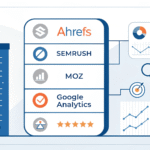
Search engine optimization (SEO) can be a daunting concept, especially for beginners or small businesses without dedicated resources. Fortunately, tools like Mangools make it easy to take control of your SEO strategy. Packed with five powerful tools under one roof, Mangools simplifies keyword research, competitor analysis, rank tracking, and more.
Whether you’re a seasoned professional or just learning the ropes, this guide will walk you through how to use Mangools step by step and show you how its features can revolutionize your SEO efforts.
What is Mangools?
Mangools is an all-in-one suite of SEO tools built to simplify digital marketing tasks. It offers a user-friendly interface and five key tools to handle different aspects of SEO without needing to spend hours navigating a complex system. These tools are:
- KWFinder (Keyword Research)
- SERPChecker (SERP Analysis)
- SERPWatcher (Rank Tracking)
- LinkMiner (Backlink Analysis)
- SiteProfiler (Website Analysis)
Mangools is ideal for digital marketers, small business owners, and bloggers who want effective SEO results without overwhelming their workflow.
Why Choose Mangools for SEO?
Before we jump into the “how-to,” let’s talk briefly about why Mangools is worth trying.
- Simple Interface for Beginners
Unlike other SEO platforms that often require steep learning curves, Mangools focuses on simplicity and ease of use.
- Affordable Pricing
Compared to premium tools like Ahrefs or SEMrush, Mangools offers a more budget-friendly approach without sacrificing essential features.
- Accuracy and Reliability
Mangools provides precise data, from search volumes to keyword difficulty, making it a reliable tool for actionable insights.
Mastering Mangools in Minutes
1. KWFinder: Discover the Best Keywords
Keyword research is the backbone of SEO, and the KWFinder tool makes it effortless. Here’s how you can use it effectively:
- Enter Your Focus Keyword
Input a term related to your business or website. For example, if you run a coffee blog, you might search for “best coffee beans.”
- Analyze by Target
Choose your target location and language to narrow down results.
- Explore Data
KWFinder will show:
- Search Volume
- Keyword Difficulty Score (KD)
- Related Keywords and Questions
Pro Tip: Focus on keywords with high volume but moderate keyword difficulty. For example, “organic coffee beans” with a KD of 36 is easier to rank for than “coffee” with a KD of 88.
2. SERPChecker: Analyze Your Competition
To outrank competitors, understanding their strategy is crucial. SERPChecker helps you gain insights into the top-ranking pages for your chosen keyword.
How to Use SERPChecker:
- Plug in your keyword (e.g., “organic coffee beans”).
- Choose your location to get SERP data relevant to a specific region.
- Review metrics like Domain Authority (DA), Page Authority (PA), backlinks, and estimated traffic.
Pro Tip: Pay attention to the weakest results on page one – they’re your best opportunity to rank higher!
3. SERPWatcher: Track Rankings Over Time
Ongoing rank tracking is essential to measure your SEO performance. SERPWatcher shows how your keywords rank and change over time.
Steps to Use SERPWatcher:
- Add your domain name and target keywords.
- Set your location to track rankings at regional or global levels.
- Monitor your “Dominance Index” (a unique metric for visibility) alongside keyword performance.
Pro Tip: Regularly update your keyword list to stay ahead of competitors in emerging niches.
4. LinkMiner: Unlock Backlink Opportunities
Backlinks remain one of Google’s strongest ranking factors. LinkMiner helps you analyze and replicate your competitors’ backlink strategies.
How to Use LinkMiner:
- Enter a competitor’s domain.
- Browse their backlink profile, focusing on backlinks with high authority.
- Filter based on link types, such as “DoFollow” or “NoFollow.”
Pro Tip: Use the “Lost Backlinks” feature to target opportunities your competitors have missed or abandoned.
5. SiteProfiler: Analyze Website Authority
Want a quick snapshot of how your website (or a competitor’s) is performing? SiteProfiler provides an overview of authority metrics, backlink data, and audience insights.
Steps to Use SiteProfiler:
- Enter your domain or competitor’s domain.
- Review key metrics:
- Domain Authority
- Trust Flow and Citation Flow
- Top Content
- Backlink Statistics
Pro Tip: Leverage the audience demographics report for more personalized marketing campaigns.
Bonus Tips to Maximize Mangools
- Schedule Weekly Reports: All Mangools tools allow automated reporting, so you can visualize progress without manually pulling data.
- Create Keyword Lists: With KWFinder, you can save keywords into lists to stay organized for different projects or campaigns.
- Combine Tools for Strategy: Use KWFinder for initial keyword research, then move to SERPChecker and LinkMiner for a complete competitive strategy.
Taking Your SEO to the Next Level
SEO doesn’t need to be overwhelming, and Mangools proves it. With its intuitive tools designed for ease and efficiency, you can transform your approach to SEO in minutes.
Are you ready to see the difference Mangools can make? Sign up today and unlock the power of simple, effective SEO!

I am Ray Jones Digital
My current occupations: a Digital Marketer, Local SEO expert, Link Builder, and WordPress SEO specialist. Shopify SEO, Ecommerce Store Management, and HTML & WordPress Developer I have been practicing the above mentioned services for more than 10 years now As an SEO expert working with your ongoing projects.



